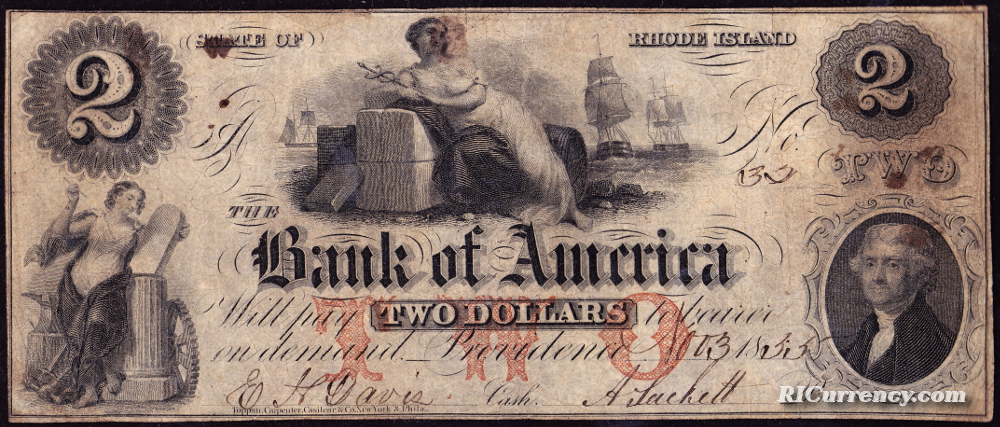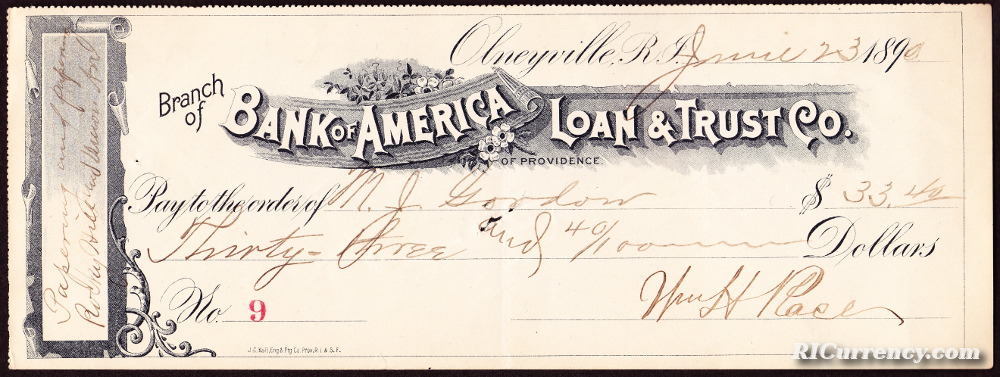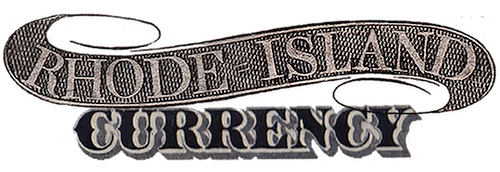Bank of America, Providence
As reported in 1891:
“The Bank of America was incorporated in May, 1851. It was located in Duncan’s Building, No. 48 Broad street, and its capital was $132,950. Its early board of directors was composed of: Adnah Sackett, Henry W. Gardner, John P. Smith, George H. Wilbur, William Spencer and Pardon M. Stone. The bank was moved about 1867 to 62 Weybosset street, which location has been since preserved. Its capital for the last 30 years has been $200,000. This has remained a state bank. The first president was Adnah Sackett. who was followed, in 1860, by Zechariah Chafee. After a long term of service he was succeeded in 1889 by William S. Hayward.
“Edward N. Davis, the first cashier, remained in that office until 1876, being succeeded by A. C. Tourtellot, the present cashier. The directors are: William Spencer, Solomon Tyler, William S. Hayward, Zechariah Chafee, Marsden J. Perry and Leander R. Peck.” — Richard M. Bayles, ed. History of Providence County, Rhode Island, Volume I. New York: W. W. Preston, 1891.
Zechariah Chafee, Sr’s long stewardship of Bank of America appears to have been uneventful. He is far better known today for his dubious handling of one of Rhode Island’s most important businesses. In 1874, Chafee was appointed the sole trustee of the A&W Sprague textile company. At the time, Sprague was a $19 million concern, the largest calico-dye manufacturing company in the world with mills across New England. The financial panic of 1873, however, threw the enterprise into turmoil and it faced heavy debts. (This, in turn, caused problems for many local banks, including the National Bank of Commerce and Grocers & Producers.)
One of the main owners of the textile empire was William Sprague, Jr., son of the founder and former Governor of Rhode Island. His wife was Kate Chase, daughter of Salmon P. Chase, Secretary of the Treasury under Lincoln and later Chief Justice of the Supreme Court.
Unfortunately, Zechariah Chafee had no experience in the textile business and sold off the A&W Sprague assets in ways that some found questionable. In the aftermath, creditors received 30 cents on the dollar and William Sprague lost everything (he had to buy back his own home in Narragansett after Chafee sold it). Not everyone was happy with these machinations, and Chafee spent the next decade fighting lawsuits over the whole affair. Years later, he was also censured by the Supreme Court of Rhode Island for buying up claims against the company and personally profiting from them.
It could be said that this is where the political ambitions of the Sprague family died, while those of the Chafees were just beginning. William Sprague and Kate Chase divorced in 1882, after Kate’s affair with Senator Roscoe Conkling was discovered. Their only son committed suicide in Seattle in 1890. William’s only asset left after the bankruptcy, his grand estate in Narragansett named Canochet, burned to the ground in 1909 and he died six years later.
As for Zechariah Chafee, he emerged from his trusteeship with his reputation intact and wealthier than ever. His grandson Zechariah, Jr., went on to become one of America’s great First Amendment scholars, who famously butted heads with Senator Joseph McCarthy during the Red Scare. Other descendants include his great-grandson John Chafee, who served as R.I. Senator, Governor and U.S. Secretary of the Navy, as well as his great-great-grandson, Lincoln Chafee, former Senator, Governor of Rhode Island and 2016 presidential candidate.
Both spurious notes below bear forgeries of Zechariah Chafee’s signature.
Another significant figure in this institution’s history is Marsden J. Perry. Perry became a director in 1881 and under his direction Bank of America was reorganized as the Bank of America Loan & Trust Company on May 9, 1890. In January of 1894, the company changed its name to the Union Trust Company and spent the next decade vying for dominance of Providence’s financial scene. (To read the story of Union Trust, click here.)
* A great number of this bank’s undated and unsigned remainder notes are available to collectors today.
** There were several institutions across the country named “Bank of America” in the 19th and early 20th centuries. This bank, founded in Providence, was not then associated with the Bank of America of today (based in Charlotte, North Carolina). Its successor institutions, however, did eventually get acquired into the fold of that mega bank (Fleet Financial/Bank of America merged in April, 2004).




A check from that brief period between 1890 and 1894 when the institution was known as the Bank of America Loan & Trust Company. It next became the Union Trust Company. This piece originates from the Olneyville branch.
